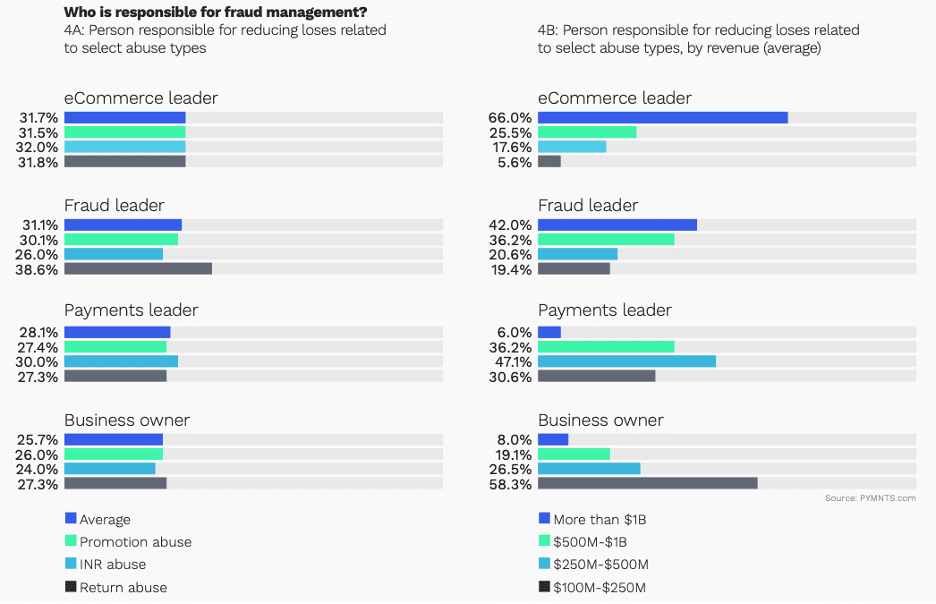Retailers Getting Hit With $90B of Bogus Returns, Promo Abuse

Losing over 2% of revenue each year would be cause for great concern for most consumers — yet for many eCommerce businesses, it’s a fact of life that they struggle to combat as bad actors abuse policies that are meant to make things easier for consumers.
PYMNTS research, conducted in collaboration with Forter, found that abuse of customer service policies costs U.S. retailers with more than $100 million in revenue as much as $89 billion per year, with the largest companies most frequently targeted and seeing the highest share of revenue lost to abuse.
For each of the three types of policy abuse — promotion abuse, item not received and return abuse — organizations typically designate a different person responsible for reducing losses. On average, only 31% of firms that have observed abuse over the past 12 months say that the designated leaders of anti-fraud efforts were responsible for the day-to-day reduction of abuse-related losses. Similar shares of companies delegate this responsibility to other managers, such as eCommerce leaders at 32%, payments leaders at 28%, and business owners at 26%.
 “Beyond eCommerce Fraud: How Retailers Can Prevent Customer Policy Abuse” is based on a survey conducted in late August and early September of 100 executives at retail businesses that generate at least $100 million in annual revenue.
“Beyond eCommerce Fraud: How Retailers Can Prevent Customer Policy Abuse” is based on a survey conducted in late August and early September of 100 executives at retail businesses that generate at least $100 million in annual revenue.
See more: Good Customers Gone Bad — Retailers Lose $89B Annually to Return Policy and Promotions Abuse
Additionally, 40% of firms that have faced abuse in the past year do not automatically track losses. Larger companies are the most consistent in tracking customer abuse loss, at 88%, but 56% of small companies, bringing in between $100 million and $200 million annually, say they use manual tracking to monitor policy abuse.
![]() Of the types of abuse, promotion abuse — or taking undue advantage of rewards, sales or other promotions — is the most prevalent, followed by item not received and return abuse. Only 11% of companies said they had not experienced any type of abuse, while 21% of firms reported experiencing all three.
Of the types of abuse, promotion abuse — or taking undue advantage of rewards, sales or other promotions — is the most prevalent, followed by item not received and return abuse. Only 11% of companies said they had not experienced any type of abuse, while 21% of firms reported experiencing all three.
No Such Thing as Free Returns
In the midst of the pandemic, customers got into the habit of checking return policies just as often as they checked delivery timeframes and shipping costs. In an interview, Narvar CEO Amit Sharma said that as most commerce shifted online, many retailers extended their return window to as long as 90 days, offering critical flexibility to consumers but also widening the window for bad actors. Return abuse, or when a consumer returns an item that is not eligible for return, impacts nearly 60% of large retailers, PYMNTS data show.
Related news: Why Smart Retailers Wish Their Customers Many Happy Returns
The National Retail Federation (NRF) estimates that as much as $428 billion in merchandise was returned last year, with online returns accounting for $102 billion, more than double the levels seen in 2019.
Part of the issue stems from “bracketing,” or the practice of ordering multiple sizes of the same item with the intention of returning the ill-fitting products. Nearly two-thirds of online shoppers say they have “bracket bought” at least once in the last year. And according to the NRF, for every $1 billion in sales, the average cost of returns is $105 million, implying that roughly 10% of operating margin takes a hit after the sale has been recorded and the cash has been received.
Still, David Morin, senior director of retail and client strategy at Narvar, told PYMNTS that it’s critical for retailers to make the return experience as easy as possible, which likely also makes it difficult to prevent policy abuse.
“Because so many more people are trying new brands, they’re also likely going to try more returns experiences, and having that seamless experience builds trust and peace of mind,” Morin said.
Read more: The Great Retail Conundrum: Easy Returns Are Costly, But Drive eCommerce Loyalty